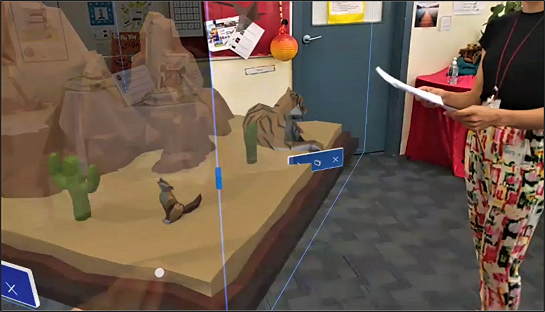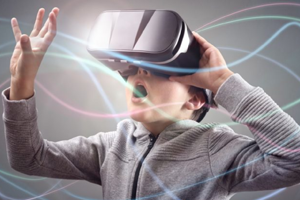
60% of Australian English teachers think video games are a ‘legitimate’ text to study. But only 15% have used one
Fresh air and life away from gaming are undeniably important. But it may help to know our research shows many English teachers are thinking seriously about how gaming applies in their classrooms – even if there are divided opinions about how to approach it.

Exclusive: New wearable 3D tech supercharging student engagement
This prediction was made by Professor Kathy Mills, of the Australian Catholic University’s Institute for Learning Sciences and Teacher Education, following a groundbreaking study into the use of three dimensional (3D) smart glasses designed to build students’ multimodal literacy.
While the majority of research on Augmented Reality (AR), Virtual Reality (VR), and Mixed Reality (MR) in education has focused on students’ consumption of learning material, the latest research was driven by a recognition that students need to create narratives, rather than simply consume them, working with transmedia narratives across modes.

Virtual reality gets students moving and learning by inspiring the senses
Immersive virtual reality is changing the way students think, comprehend, express themselves and create texts by using their whole bodies, according to ACU research.
A new study of 47 primary school students aged 10-11 found students’ senses were expanded through a much larger range of body movements when using VR technology, compared with those used during conventional writing and drawing.
“These movements activate the brain in ways that are very different to when students are seated at a desk and involves the orchestration of multiple senses for high learning engagement,” lead author Professor Kathy Mills, of ACU’s Institute for Learning Sciences and Teacher Education (ILSTE), said.

Reality Check In Schools
SCHOOLS are no longer just eaching the 3Rs of reading, writing and ‘rithemtic. A new “R” – VR or virtual reality – is being used in classroom as learning tool. Research from Australian Catholic University shows virtual reality is changing the way students think, comprehend and express themselves.

The Future of the Digital Turn in New Literacy Studies, Germany Research Exchange Day
Keynote by Professor Kathy Mills “The Future of the Digital Turn in New Literacy Studies”, Australian Catholic University at Brisbane, 31 March 2022, at the Symposium “Digitality and Normativity in Informal and Formal Learning Contexts” at Friedrich-Alexander-Universität Erlangen-Nürnberg, Germany

“Technology learning in the classroom: Six tips to get it right”
Australia was one of the first countries in the world to have more computers than students in schools. But as the numbers of computers and other technological devices increased, student performance did not. The days of cramming computers into classrooms and expecting improvements in learning are numbered.
Some argue there’s little evidence to justify investment in technology in the classroom. In fact, some studies even suggest potential harms. Some have suggested links between screen time and increased ADHD, screen addiction, aggression, depression, and anxiety, dizziness, headaches and blurred vision.

Grant Award
On 02/08/2018, the Minister for Education and Training, Senator the Honourable Simon Birmingham announced that ILSTE Researcher, Professor Kathy Mills, was successful in being awarded a highly prestigious Australian Research Council Future Fellowship. Professor Mills’ project was the only approved project nationally in the Education field of research.

Use emojis in NAPLAN: kids’ literacy expert
NAPLAN could learn from the emoji icons made famous by smart phones, by including new digital literacies as a way to measure kids’ language skills, according to a children’s digital technologies and literacy expert.
Australian Catholic University’s Literacies and Digital Culture Professor, Kathy Mills, was speaking today on World Emoji Day, 17 July.
Ten years after NAPLAN testing commenced we are finding Australian children’s literacy is not improving in any consistent way, Professor Mills said.
Taught with instruction on emotive language, selfies, gifs, memes and emojis are examples of every day literacy practices used by young people today that can empower and improve their language skills. We need to adapt NAPLAN to include 21st century, digital forms of communication in their assessment of literacy.

What is the future of writing?
What is the future of writing? Why can’t kids today write in cursive? Can we expect more rapid cultural shifts in the future due to globalization and technology?
Professor Kathy Mills, author of Literacies in the Digital Age and The Multiliteracies Classroom, was recently interviewed by Nancy Herther for the USA publication, Against the Grain.

Bakhtin and the carnival: humour in school children’s film making
While humour and laughter create conditions that are conducive for learning, different forms of children’s humour have been given little attention in research on digital media, literacy learning, and multimodal design. Applying a Bakhtinian lens, we analyse carnivalesque videos created by elementary students as part of the formal curriculum.

How to Create a Connected Classroom: Tools, Boundaries and Considerations
From iPhones to smart homes, technology plays a pivotal role in our everyday lives. Our devices can often be likened to a second brain, reminding us when to wake up, how to eat right and where to head on the highway. And while technology can’t teach students everything they need to know, it can certainly be useful to them and their teachers.When using tech in the classroom, striking the right balance is key. Here’s how to create a connected classroom that makes the best of technology, ensuring student success and well being across all fronts.

How to use technology to foster higher-thinking skills in class
Teachers want to encourage higher-level thinking skills among their students. Many fear technology can make students passive consumers of the vast amounts of information they encounter, instead of encouraging them to think critically. Distraction is another concern. A Gallup poll found that nearly 30 percent of teachers believe the use of digital devices in school is harmful — rooted in the fear that these devices can be distracting rather than contributing to critical thinking.
